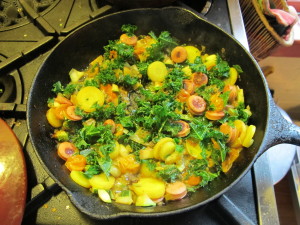Being Healthy: Growing and Eating Food That is Safe
We’ve come a long way from the day when most families grew their own vegetables and had a few chickens and a cow. From the day when fertilizer was manure of some sort, and when bug control was largely picking off the slugs and bugs. My mom (Elfrieda Lenat, 1916-2009) grew up like that. As a boy we grew a lot of our own organic vegetables, but lacked the farm animals- even though I longed to raise some chickens.
Since my mom’s youth much has changed at the grocery store, too. We are buying more processed foods, foods that contain corn and soy products grown with genetically modified organisms (GMO’s). We are buying produce that has been sprayed with pesticides and grown with chemical fertilizers. The fresh fruits and vegetables from the
store are, we assume, safe to eat. This is America, after all, where our government looks out for us.
But the government is not able to test every box of strawberries or bag of apples to see if there are harmful chemicals in the fruit. According to recent government statistics, the Department of Agriculture tests about one tenth of one percent of fresh produce coming into the country for chemical residues, and less than one percent of our American-grown fruits and vegetables.
We all know that any food identified with a green sticker that says USDA certified organic does not include genetically modified ingredients, and that any sprays have been approved by OMRI, the organic certifying board – though some can still be strong natural pesticides from plants, for example. What about “natural” or “all natural” labels? They have no regulatory meaning. Our own home grown food? If you don’t use chemicals anywhere on the property, those are safe.
But organic food is more expensive, and sometimes we have to make choices. According to the non-profit organization, Green America, the 10 fresh vegetables and fruits you should buy organic at the grocery store are: apples, bell peppers, celery, cherries, imported grapes, nectarines, peaches, pears, potatoes, raspberries, spinach and strawberries. Save that list, and bring it with you the next time you go to the grocery store – or memorize it. And you can trust your local farmer using an Integrated Pest Management program (IPM) to have safe, fresh food in season, too. Just ask about IPM at the farm stand next summer.
So for example, conventional strawberries from California are big and beautiful – and available almost all year round. But the California growers have lobbied successfully with our government, and they have a loophole in the law. They are allowed to use methyl bromide, a fumigant that they pump into the soil, and then seal it in with a layer of plastic. This kills every living thing, including the fungus called Fusarium wilt that can wipe out a crop of strawberries. Most other countries have banned methyl bromide for its toxicity and for what it does to our ozone layer. But money talks, and lobbyists prevail. Me? I won’t buy strawberries from California, or eat them even if they’re served as a garnish out of season (meaning they are probably from California.)
But let’s go back to corn and soy, which are found in virtually all processed foods from sodas and chips to frozen pizza and turkey pot pies. Virtually all non-organic corn and soy is GMO and is resistant to a chemical herbicide, glyphosate, commonly sold as ‘Roundup’. Roundup makes farming easier and cheaper – by eliminating weeds. So corn and soy fields are sprayed with glyphosate to kill weeds, and the grains are not harmed. But glyphosate is taken up by the corn and soy, so it ends up in our food.
The Environmental Protection Agency (EPA) considers glyphosate safe to use, and the USDA not monitor glyphosate levels in food. Nor does the manufacturer have to say what the “inert” ingredients are in the product, as this information is consider a trade secret. But inert does not necessarily mean inert to us or the environment. Inert to the EPA just means those ingredients do not play a role in killing weeds. Since we don’t know what they are, I want to avoid them.
But here is what makes me most nervous about ingesting glyphosate: even though it does not affect my metabolism directly, it does affect the bacteria which play an important part in my good health. The same metabolic pathway that allows Roundup to kill weeds is an important metabolic pathway in bacteria. So I won’t use glyphosate too kill weeds, and try to avoid food that has been treated with it. That means avoiding processed food.
What about conventional meats, milk and eggs? Glyphosate is showing up there, too, because animals are fed GMO corn as feed – which is treated with glyphosate. So unless you buy organic meats or know that your local farmer is not using feed with GMO corn in it, you can ingest glyphosate from your meat. If you buy your meats at your local farmers market, you can ask your farmers what they feed their animals.
So, as we head into the season for starting seedlings indoors, think about expanding your vegetable garden to include more food that you can store for winter use – or just enjoy fresh off the vine in summer. If you grow your own vegetables, you can insure that your food is safe – and chemical free. I do it, and it feels good.
Henry’s web site is www.Gardening-Guy.com. He is the author of 4 gardening books and a fantasy-adventure for children about a boy and a cougar.



